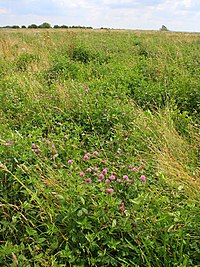
Photo from wikipedia
Abstract The impact of long-term inputs of mineral nitrogen (N) fertilizer and swine manure on soil alkaline phosphatase activity is important for phosphorus (P) availability, although its associated gene abundance… Click to show full abstract
Abstract The impact of long-term inputs of mineral nitrogen (N) fertilizer and swine manure on soil alkaline phosphatase activity is important for phosphorus (P) availability, although its associated gene abundance and diversity within the soil bacterial community are poorly understood. Topsoil (0–10 cm) samples were taken from triplicate field plots that had been maintained under continuous maize (Zea mays) cropping for 28 years with either no nutrient inputs (control), annual inputs of mineral N (urea), swine manure, or combined mineral N-swine manure. Potential alkaline phosphatase activity was determined, together with phoD gene abundance and diversity that using real-time quantitative polymerase chain reaction (PCR) and high-throughput sequencing. Results showed that potential alkaline phosphatase activity and phoD gene abundance were markedly lower in soil from the mineral N treatment compared with the control. On the other hand, long-term swine manure inputs, with and without mineral N, decreased potential alkaline phosphatase activity and phoD gene abundance compared with the control, although concentrations of plant-available P were higher in manure-amended soils. Distinct separation of phoD gene bacterial communities were associated to each fertilization regime, while less pronounced separation was observed between control and mineral N-swine manure treatments. Furthermore, long-term mineral N and swine manure inputs altered the phoD gene community composition. The relative abundance of Bradyrhizobium was higher in mineral N than control soils, and Pseudomonas was less abundant in swine manure than control soils. Our results indicated that long-term application of mineral N in the absence of P inputs significantly reduced potential alkaline phosphatase activity, abundance and community diversity of phoD gene was attributed to a combination of factors, including a 10-fold increase in soil acidity, decreased soil microbial activity, and the apparent inherent stability of organic P in this soil. The findings of this study demonstrated that long-term mineral N inputs adversely impacted the dynamics and bioavailability of P in soil maintained under continuous cropping.